Self-taught textile artist Daniella Jordan specialises in producing hand-made, hand-dyed fabrics from her North Island home. Her beautiful textile prints are produced with sustainable, organic and non-toxic materials, and tap into the beauty of the local plants we see every day and often take for granted. We talked to Daniella about her inspirations – and her fascinating dye process.
Tell us about what you make
I hand-dye textiles with natural dyes, using both immersion and contact-dyeing methods. Much of my stock consists of eco-printed silk scarves, but I also dye fabric and turn it into one-off dresses, as well as re-dyeing pre-loved clothing such as shirts, tops, dresses and skirts. I like to recycle where I can. In addition, I make silk and merino felted scarves, shawls and wraps, using lovely New Zealand fibres and often incorporating eco-dyed bamboo, spaghetti and mulberry silk and mohair.
How did you get into contact dyeing and textile printing?
I have always loved working with my hands – as a child, we went through long periods of time with no TV, which I didn’t like much at the time but which I am now grateful for, as it meant that we had to find something else to do. I loved drawing, and also spent a lot of time knitting and crocheting, embroidering, sewing and, yes, darning socks! In later years, I took on bigger sewing projects – I made a friend’s bridesmaids’ dresses and my sister’s wedding dress, and then clothes for my own children.
After I started teaching at our local Steiner school here in Hamilton, I became interested in fibre and dyes, as I wanted my class of 13/14-year-olds to learn about how clothes used to be produced. We washed raw fleece, carded and dyed it, spun it and wove it – but my favourite part was the dyeing. I then came across a beautiful book called Eco-Colour by a fabulous Australian textile artist called India Flint, who has produced ground-breaking naturally dyed textiles using contact dyeing methods – transferring colour direct from the leaf to the fabric, and I was inspired. I devoured the book, and then was determined to learn how to do it myself. I’ve been obsessed ever since.
Do you have formal training or qualifications in your craft?
No – I have learned from books, blogs, and lots of trial and error. I was lucky enough to attend workshops in dyeing at the Titirangi Steiner School and with fabulous felt artist Pam de Groot, as well as a 3-day residential course in beautiful Nelson with India Flint herself. I’ve taken wet-felting workshops and learned a lot from YouTube tutorials.
Your favourite materials, tools and processes?
I work primarily with silk, and it never fails to fascinate me – the textures and the sheen, the warmth and the strength of it. Also I use a lot of fine merino fibre – soft, warm, and very beautiful, especially when it’s felted into silk gauze. Occasionally I produce something really wild and woolly using New Zealand grown English Leicester woollen locks or Gotland fibre.
My favourite leaves to use for eco-printing – roses, geraniums, griselinia, maple and eucalyptus, all produce gorgeous colour and beautiful prints. I have also grown my own woad for the last couple of years (which is the plant the ancient Britons used to use to colour themselves blue). I get such a buzz about being able to colour my fabrics with leaves I have foraged from my garden, and from places where I walk my dogs.
Tell us about some of the techniques involved in producing one of your scarves
Eco-printing is a really exciting way of dyeing fabric, and it’s particularly brilliant on silk. I lay out the scarf, and arrange my selection of leaves on the fabric. I then wrap it tightly around a piece of dowelling, tie it firmly with string and simmer it in water for anything from 45 minutes to an hour and a half, depending on the leaves I’m using. This process extracts the pigment from the plant material, which then direct-dyes the fabric. I should then leave it to cool in the pot, but I’m not very good at waiting. I’m always too eager to see what’s happened. Depending on the colour effect that I want, I will sometimes dip the finished scarf in a solution of rusty water and vinegar, or a weak solution of washing soda. I often use the same method to colour my silk chiffon before felting merino fibre into the fabric to make my shawls and wraps. The results can be incredibly delicate and detailed, or really bold and beautiful.
As far as inspiration for my craft is concerned, I could easily waste a huge amount of time on Pinterest and Instagram, looking at other textile artists’ work. There are so many hugely talented international dyers out there, and I am constantly amazed at the beautiful effects that are possible using natural dyes. It gives me something to aspire to in my own work.
Is there a philosophy behind your work?
Wherever possible I like to use natural, sustainable resources from as close to home as possible, with as little impact as possible on the environment. Apart from my scarves, I also re-dye a lot of pre-loved clothing and I work with vintage cotton sheeting which I sew into dresses – so much is thrown away that could get a new, beautiful and individual lease on life. I hate waste!
Describe your creative process
Because I’m working with plant material, what I produce is dependent on what’s in season at the time, or what I have managed to store – so that will dictate what sort of colours I can produce in my work. This in turn influences how I lay out my leaves on my fabric. Depending on what I’m working with, I often don’t go into my work with particularly fixed ideas – if I’m working with a big piece of fabric, or scarf blanks, I start to lay out what I have available and then go with the flow. However, with some of my garments I am quite particular about my layout – cutting out the pattern pieces first and laying out the plant material in a precise manner depending on the kind of effect I want to produce. Occasionally the results can be a little disappointing, but I have my favourite reliable leaves that I know will work and more often than not nature will produce something really beautiful, and sometimes quite surprising.
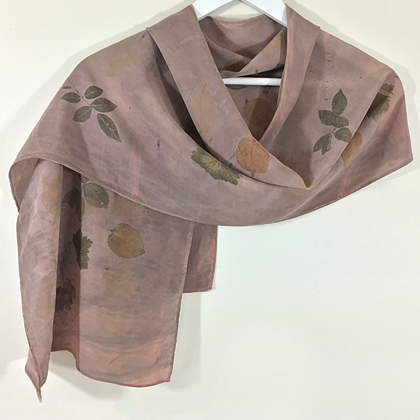 Describe your workspace
Describe your workspace
One of these days I would love to have a dedicated studio (and I’m sure my family would be keen too!). During good weather I can work outside on the deck, but otherwise I take over the big table in our dining room for laying out and for felting. The laundry gets used a lot, and I have buckets of mordants and pots and pans outside the back door. It does tend to take over certain parts of the house!
Five words that describe your mind:
Enthusiastic, agile, inquiring, appreciative and, my son says, stubborn!
Your favourite feedback from a customer:
I love it when people come in to my stall at the local market and say “This is my favourite stall”. You can’t get better than that.
What are you currently listening to?
Right now I’ve turned everything off so that I can focus, but when I’m working at home during the day, I’m an avid listener to the BBC World Service. I like to stay informed about what else is happening in the wider world.
Recommend an album:
The Bends by Radiohead – it reminds me of grungy student days back home in Devon.
What was your favourite childhood book, and why?
As a child I think my favourite novel was The Lion, the Witch and the Wardrobe. Who wouldn’t want to pop out of the back of the wardrobe into a magical other world?
What are you reading now?
Black Dogs by Ian McEwan. I love how non-judgmental he is about his characters, with all their flaws and their humanity, and he’s one of the few male writers who can really write realistically from a woman’s point of view.
Who is your hero or heroine, and why?
On a grand scale, Mahatma Gandhi – to be able to effect such change in a non-violent manner is a lesson the whole world should learn from.
A favourite quote:
The first one that springs to mind is one my Dad used quite a bit when my sisters and I were children: “The wise old owl sat in the oak. The more he heard, the less he spoke. The less he spoke, the more he heard. Wasn’t that a wise old bird.” I think he was trying to tell us something…
Tell us about your pets
We have two dogs – a Huntaway cross and a little Fox Terrier/dachshund cross. They’re adorable and crazy, and utterly loyal. We also have two cats, who rock up at the house when they need feeding but otherwise seem to spend most of their time out and about in other people’s gardens.
What would your advice be for those starting out in a crafty business?
Work with something you are passionate about. You need to find joy in what you do, if you’re going to be spending a lot of time doing it.
What was the last handmade item you bought and what attracted you to it?
Handmade soap from Wouldn’t Know ‘Em From a Bar of Soap, a regular stall at our local market. I always buy from them every month – their product smells so gorgeous and I love the subtle colours they use.
What’s in store for the rest of 2017?
I have a list… Christmas is coming, and I’m gearing up for markets here in the Waikato, and also the General Collective Market in Auckland at the beginning of November. I supply a local gallery, Inspirit Gallery run by the lovely Jenny Scown who has been really supportive of my work. And I’m keen to improve my photography skills and load a lot more of my products into my online shops. I have dye-plant seeds planted up, so I foresee some gardening in my near future. I’ll be growing woad again this year (for blue dye), as well as weld, tansy and chamomile (yellow) and will harvest some of my three-year-old madder roots (produces a wonderful red dye) at the end of the season. Once the rush is over, I’d really like to get a bit better at documenting my experiments and results. I really need to get organised!
Prize draw!
Daniella has very kindly offered a beautiful prize for one lucky Felt reader of this stunning eco-dyed silk scarf, valued at $60.00 (see right). This delicate silk crepe de chine scarf is eco-dyed with real leaves and overdyed with brazilwood dye. It measures approximately 36cm x 173cm.
To be in to win this lovely prize, simply leave a comment telling us what you loved about Daniella’s story and her creations. The draw will be made on Friday 6 October and is open to New Zealand residents only.

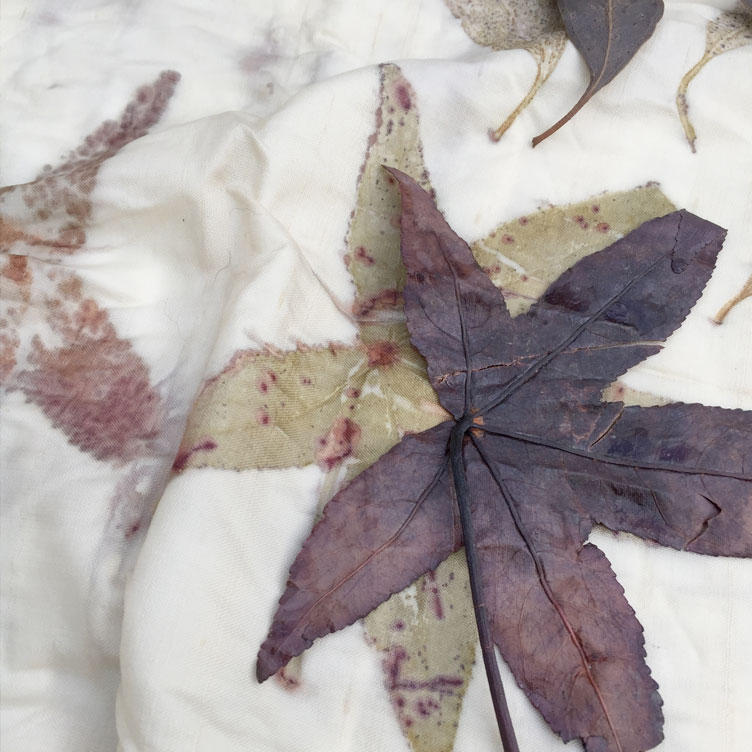
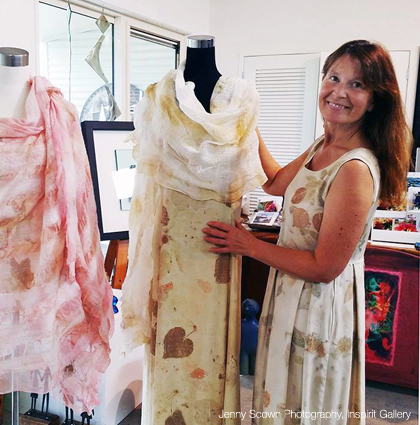
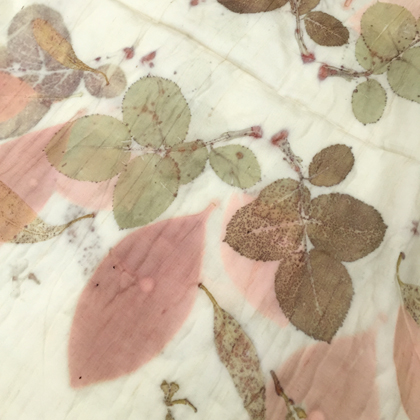
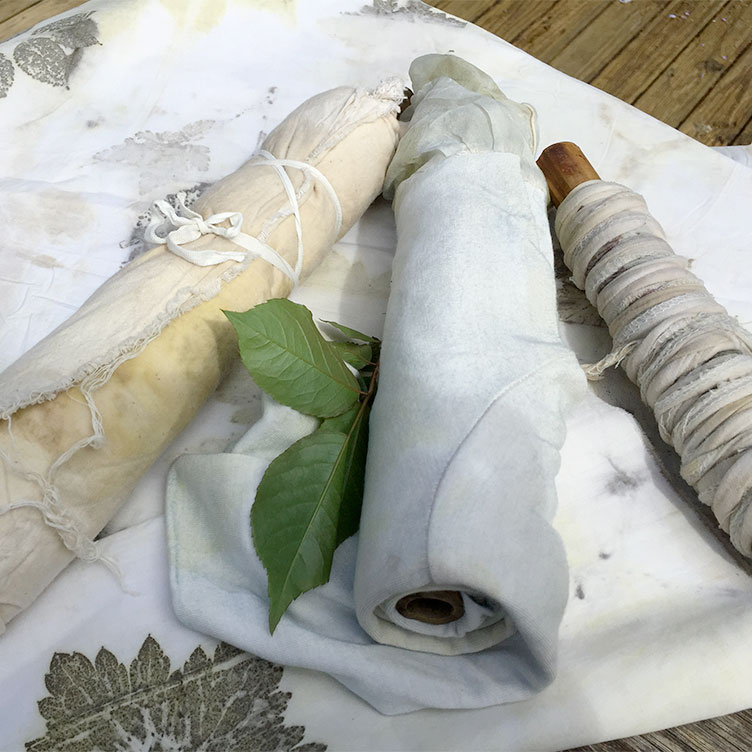
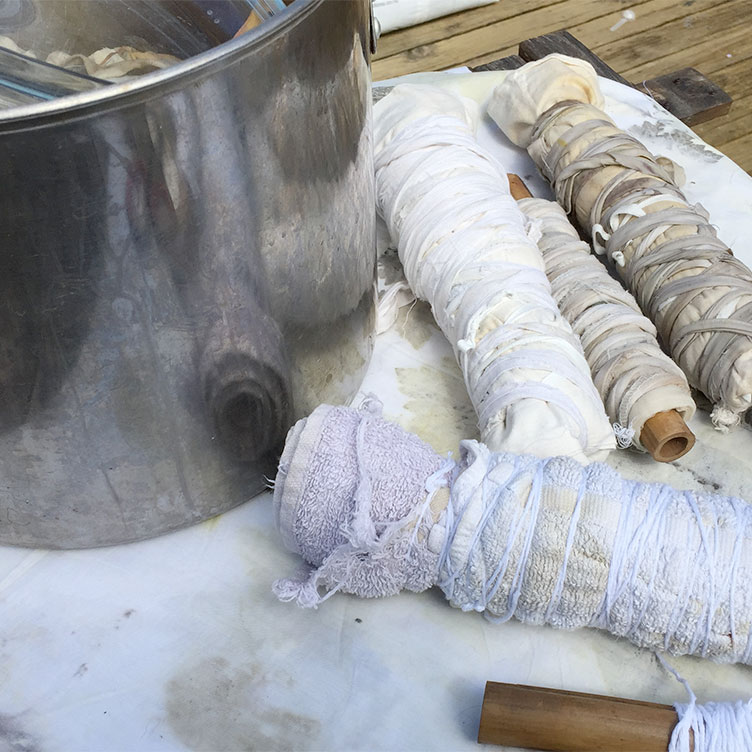
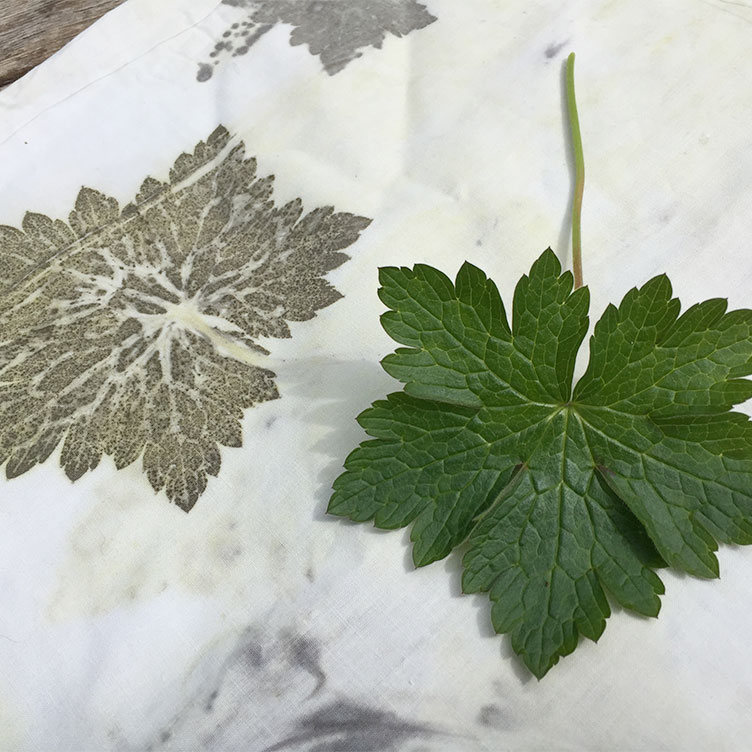
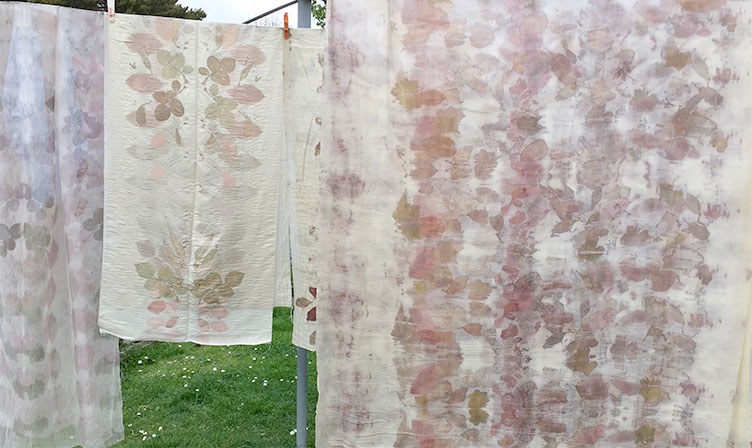

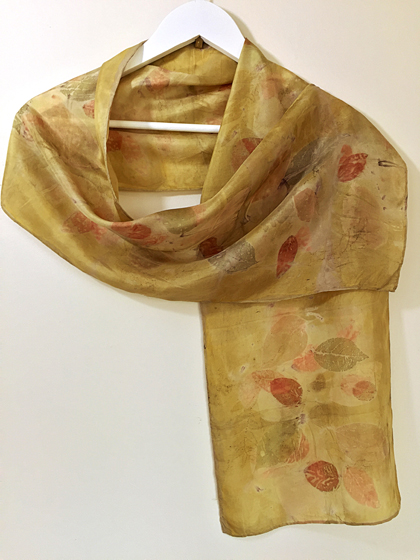
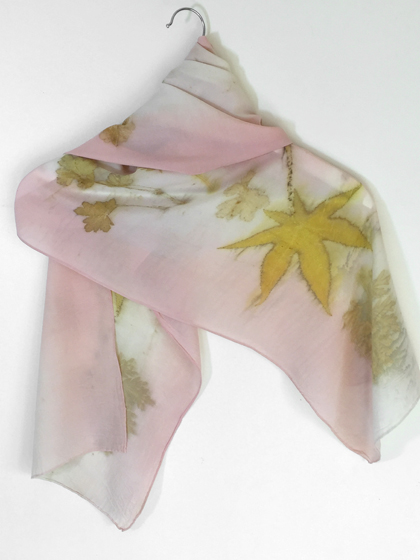
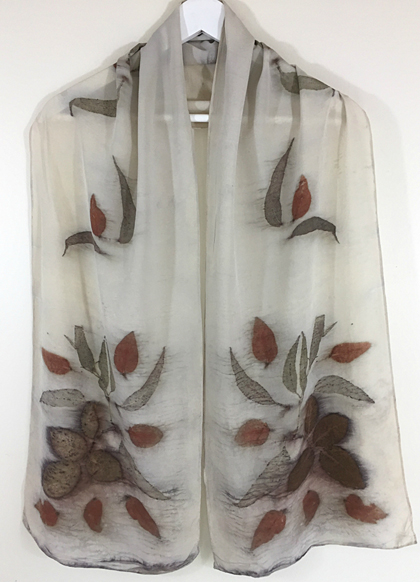
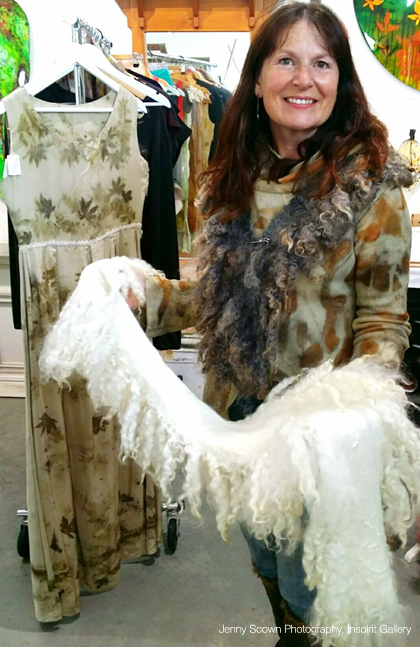





Hello Daniella, I would love to win one of your beautiful works. Great photo of you holding up your work. You can see your passion and enjoyment in your creative work
Hi Daniella
Could you please make contact with me as I wizh to discuss some sample scarves with
It’s really great to discover someone in New Zealand doing eco-dye fabrics. I have been following India Flint’s work on Instagram for a while but did not know of anyone here doing artwork in this area. The results are really beautiful. I hope I can see your fabrics and clothing in person next time I am in Hamilton. I use leaves and plants in my own artwork and it’s really inspiring to learn about other people using natural materials in different ways.
Truly gorgeous fabric and pieces of clothing. So beautiful to wear and have as part of your life. Talented lady.
Such beautiful creations! I really loved that you began this work from showing students the process of how things used to be made… it took you deeper and then the teacher becomes the student! What a lovely, creative journey. Blessings, Leah
Such stunning and beautifully crafted scarfs, love how nature has inspired you and the natural uses of dye.
I love that through teaching others you’ve also found your own passion. Your work is beautiful. I want to go and play with flowers and leaves now.
Reading this story was really inspiring! I’ve always wanted to try using natural dyes and Daniella’s techniques are fascinating. Her pieces are beautiful (and I love how they’re environmentally friendly too!).
Love your work and your story. Nature is wonderful to work with.
stunning and fascinating!
How incredibly fascinating your process is. The silk looks so beautiful with the leaves all printed on it, well done for creating such truly unique items
I love this post! Daniella’s story is so similar to my own – learning your art informally over time, by trial and error and online resources. I’m not very disciplined at documenting my experiments and process either 🙂 The soft colours and raw natural forms in your work are just beautiful – I’m not surprised that your stall is a favourite for many people.
Such beautiful work! I just love the soft and natural shades on lovely garments!
Wow, your work is absolutely stunning! I adore how you’ve managed to capture the beauty of nature while still making garments that are stylish and functional. A true talent and obvious labour of love!
Congratulations on developing your art and sharing it!
Thanks for making me remember how I used to like experimenting with dyes – some natural, some not, when I was at uni. Also remember a friend of the family who used to dye a lot of wool at home.
It’s fascinating the effect of the leaves and the petals, and very pretty!
I am awe struck with interest & I love what you are creating. Beautiful – the process you embrace & the finished garment! Thank you!
Wow, so beautiful, each one is like an individual work of art .Fascinating reading about how they are made and the talent behind them. Thanks for sharing, really enjoyed reading the article.
It’s great to learn more about you Dani. I can imagine the trials that you must have gone through to produce such amazingly original and creative work. I really appreciate your work and love that you always take the time to chat when we happen to be at the markets together.
An amazing story of incredibly gifted Lady!!! We love your work, Dani! We have some of your scarves, which look as stunning, as they looked 2 years ago!Wishing you every Success!
Wow Dani, what an interesting artical. You are so clever and I am such a fan of your work with natural plant dyes. The results are magical.
Wow! I can see why your stalls are considered favourites. Beautiful work 😀 I liked reading about your process – you make it sound easy but I know there must be a real skill to perfecting this art … and lots of patience required!